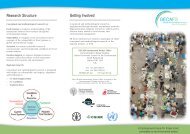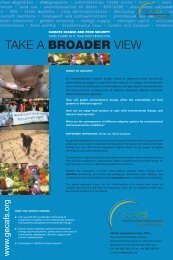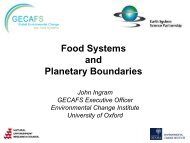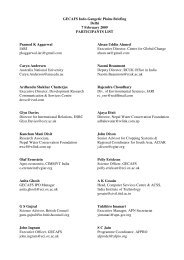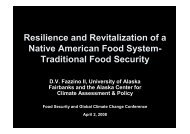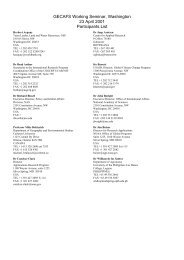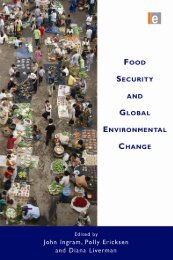pollutants were then introduced as fac<strong>to</strong>rs that reduce crop growth, thereby determining the‘actual’ yield. The notions of ‘potential’, ‘attainable’ and ‘actual’ therefore differentiateclearly the fac<strong>to</strong>rs that define, limit or reduce yield, respectively (Bouman et al., 1996; vanIttersum and Rabbinge, 1997). (‘Available’ was later described in the Report “Realizing thepromise and potential of African agriculture” (InterAcademy Council, 2004) <strong>to</strong> recognise thata proportion of the actual harvest was lost post-harvest, resulting in a further reduced amoun<strong>to</strong>f food that is actually available for human consumption.)This production ecology approach was based on the concept of a single limiting fac<strong>to</strong>r which,once overcome, would allow growth <strong>to</strong> increase until it was restricted by another limitingfac<strong>to</strong>r (the ‘minimum function’). A number of crop, crop-soil and crop-soil-pest modellingapproaches have been developed relating <strong>to</strong> a range of production situations, i.e. potential,water and/or nutrient-limited (van Ittersum et al., 2003). Differentiating the ‘potential’,‘attainable’ and ‘actual’ concepts is very useful for application in other areas of researchwhere there also is a set of limiting fac<strong>to</strong>rs. In the case of carbon sequestration in soils, forinstance, soil mineralogy, net primary production and erosion are among major defining,limiting and reducing fac<strong>to</strong>rs, respectively (Ingram and Fernandes, 2001). A key point aboutthis approach is that interactions between limiting fac<strong>to</strong>rs are additive not multiplicative.Dalgaard et al. (2003) define agroecology as “the study of the interactions between plants,animals, humans and the environment within agricultural systems”. The general construct ofagroecology is therefore broader than the initial production ecology concept, which wasbased on a single limiting fac<strong>to</strong>r. It does however draw on this, but includes also theecological notions of interconnectivity, community behaviour and spatial organisation. Itbuilds on the community ecology notion of Clements (i.e. including “higher hierarchicallevels than the organism [the plant]”), and the worldview of Tansley, which included bothbiotic entities and their environment (Dalgaard et al., 2003). In this regard it is also alignedwith a fuller notion of production ecology (i.e. including the interactions with lives<strong>to</strong>ck), butincludes integrative studies not only within agronomy and ecology but also includingenvironmental science more generally. Interdisciplinarity and scaling across spatial levels areboth central tenets and the broad agroecology concept thereby helps move the debate <strong>to</strong>wardsthe needs discussed in Paper 2, and thus <strong>to</strong>wards the broader food security agenda. (Thefurther broadening of both concepts is discussed below.)It is important <strong>to</strong> note that the ‘eco’ letters in the word ‘agroecology’ do not denote – letalone advocate – a particular approach, as recommended by De Schutter in his SpecialRapporteur report on the right <strong>to</strong> food, presented <strong>to</strong> the UN General Assembly in December2010 (De Schutter, 2010). His argument that agroecology “seeks ways <strong>to</strong> enhance agriculturalsystems by mimicking natural processes” is incorrect; agroecology does not seek <strong>to</strong> mimic‘natural processes’ but apply ecological principles <strong>to</strong> help understand how agriculturalsystems operate and can be better managed. While “integrating crops and lives<strong>to</strong>ck;diversifying species and genetic resources in agroecosystems over time and space; andfocusing on interactions and productivity across the agricultural system, rather than focusingon individual species” can all be accommodated within agroecological concepts, its “core114
principles” do not “include recycling nutrients and energy on the farm, rather thanintroducing external inputs”. Agroecology does not advocate organic or low-inputagriculture. It is a board concept, providing a framework for investigating the ways of linkinga range of inputs (germplasm, nutrients, pesticides, water, energy) with the goods andservices we seek from agricultural systems in the context of the natural resource base.Both the production ecology and agroecology approaches have been further developed <strong>to</strong>consider fac<strong>to</strong>rs operating at higher spatial levels, i.e. farm, landscape and even region.Examples include integrated approaches for agro-ecological zonation and regional yieldforecasting (Bouman et al., 1996); scenario studies for exploring the effect of environmentalor socioeconomic changes on agriculture such as the ‘Grounds for Choices’ study(Netherlands Scientific Council for Government Policy, 1992; Rabbinge and Van Latesteijn,1992); for ex-ante evaluation of public policies for sustainable agriculture at landscape level(Parra-López et al., 2009); and for exploring multi-scale trade-offs between natureconservation, agricultural profits and landscape quality (Groot et al., 2007). Interactions withlives<strong>to</strong>ck (i.e. the whole farming system) are also critically important in many parts of theworld, and particularly in helping farmers cope with uncertainty regarding future threats andpotentials (Darnhofer et al., 2010). The boundary between the two approaches are in effectbecoming less distinct as researchers move <strong>to</strong>wards addressing problems at regional <strong>to</strong> globallevels, integrating other environmental objectives in addition <strong>to</strong> food production.While the production ecology and agroecology concepts have therefore moved well beyondfood production at local level <strong>to</strong>wards food availability at higher levels neither, however,addresses the broader issues underpinning food security. For instance, affordability, foodallocation and cultural norms, food preferences and the social and cultural functions of food,and food safety, all need <strong>to</strong> be fac<strong>to</strong>red in. This needs additional analyses of the consequencesof human activities as a chain of effects through the ecosystem and human social system.This is the realm of human ecology, encompassing elements of sociology concerned with thespacing and interdependence of people and institutions (Marten, 2001). As with bothproduction ecology and agroecology, the study of human ecology is composed of conceptsfrom ecology including interconnectivity, community behaviour, and spatial organisation.‘Interaction’ is a fundamental concept of human ecology and is a function of scale, diversityand complexity. Together with political economy and entitlement relations, human ecologyhas been seen for some time as a causal structure of food system vulnerability, and hencefood insecurity (Bohle et al., 1994). Concepts from human ecology are very relevant for foodsystems analyses given the importance of the linkages between the wide range of ac<strong>to</strong>rsinvolved and the outcomes of their varied activities.‘<strong>Food</strong> system ecology’ based on integrating concepts<strong>Food</strong> security planning can be enhanced by integrating concepts from production ecology,agroecology and human ecology with concepts of food systems and scales.Understanding the interactions between the many activities and associated stakeholder115
- Page 1 and 2:
From Food Production to Food Securi
- Page 3 and 4:
From Food Production to Food Securi
- Page 5 and 6:
Table of ContentsAbstract .........
- Page 7 and 8:
Paper 6: Undertaking Research at th
- Page 9:
AbstractFood security is a conditio
- Page 12 and 13:
2010 about 925 million people had t
- Page 14 and 15:
water) are used, and reduce negativ
- Page 16 and 17:
While the flow of the argument abou
- Page 18 and 19:
determine interactions along and be
- Page 20 and 21:
Paper 3: A Food Systems Approach to
- Page 23:
From Food Production to Food Securi
- Page 26 and 27:
concerns and are now issues that mu
- Page 28 and 29:
the relationships between GEC and f
- Page 30 and 31:
Theme 2 aims to understand how comm
- Page 32 and 33:
GEC and the Food System of the Indo
- Page 34 and 35:
Paper 2: The role of agronomic rese
- Page 36 and 37:
These advances have resulted from a
- Page 38 and 39:
Crop selection to determine mechani
- Page 40 and 41:
Agronomic science is central to imp
- Page 42 and 43:
Agronomic research in relation to f
- Page 44 and 45:
The discussion above identifies a n
- Page 46 and 47:
interventions and political inertia
- Page 48 and 49:
While research on producing food ha
- Page 50 and 51:
Box 1 Food system Activities and fo
- Page 52 and 53:
In addition to broadening the debat
- Page 54 and 55:
options. Examples already seen rang
- Page 56 and 57:
Figure 3 Outcomes for 10 variables
- Page 58 and 59:
Figure 4 Nine ‘planetary boundari
- Page 60 and 61:
Figure 5 Environmental change, food
- Page 62 and 63:
Table 1: Indicative analysis of the
- Page 65:
From Food Production to Food Securi
- Page 68 and 69:
Trade Agreement (NAFTA) and the Eur
- Page 70 and 71:
Parry et al., 2005). Conducting foo
- Page 72 and 73:
is provided in the ESF/COST Forward
- Page 74 and 75: Paper 5: Engaging Stakeholders at t
- Page 76 and 77: into actions (strategies, policies,
- Page 78 and 79: Box 2 Engaging with stakeholders in
- Page 80 and 81: Box 3 Setting the research agenda f
- Page 82 and 83: Third, and of considerable practica
- Page 84 and 85: Figure 2: Organizing and understand
- Page 86 and 87: organizations made up of numerous n
- Page 88 and 89: Elements of good practice in stakeh
- Page 90 and 91: Finally, it is worth noting that fo
- Page 92 and 93: development (Lee, 1999; Gunderson a
- Page 94 and 95: Box 7 The GECAFS stakeholder survey
- Page 96 and 97: ‘break down’ what might be a hi
- Page 98 and 99: Paper 6: Undertaking Research at th
- Page 100 and 101: agriculture in many parts of the wo
- Page 102 and 103: gaps. The presence of a strong tech
- Page 104 and 105: an average of two years to coalesce
- Page 106 and 107: Institute for Meteorology and Hydro
- Page 108 and 109: Identifying case study sitesResearc
- Page 110 and 111: can both benefit from and contribut
- Page 112 and 113: Box 5 Mapping stakeholder interests
- Page 114 and 115: Holding planning meetings in locati
- Page 116 and 117: This reorientation of the debate fr
- Page 118 and 119: Importance of this type of research
- Page 120 and 121: Integrating the food system concept
- Page 122 and 123: awareness of the GEC issues within
- Page 126 and 127: communities operating in food syste
- Page 128 and 129: Improving input-use efficiency acro
- Page 130 and 131: governance focuses on the range of
- Page 132 and 133: Developing research agendas in supp
- Page 134 and 135: The renewed approach to interdiscip
- Page 136 and 137: BIELAK, A., HOLMES, J., SAVGÅRD, J
- Page 138 and 139: EAKIN, H. 2010. What is Vulnerable?
- Page 140 and 141: GODFRAY, H. C. J., BEDDINGTON, J. R
- Page 142 and 143: INGRAM, J. S. I. & FERNANDES, E. C.
- Page 144 and 145: LYUTSE, S. 2010. The One Billion To
- Page 146 and 147: RAYNER, S. & MALONE, E. L. 1998. Hu
- Page 148 and 149: UNDP 2006. The 2006 Human Developme
- Page 150 and 151: activities “from plough to plate
- Page 152 and 153: contribution to the science agenda:
- Page 154 and 155: urgently needed, and - given the gr
- Page 156 and 157: GECAFS plannenmakerij stelde vast d
- Page 158 and 159: ieder hun eigen groep van betrokken
- Page 160 and 161: het gebied van beheer hebben betrek
- Page 162: Curriculum VitaeFollowing a BSc in



